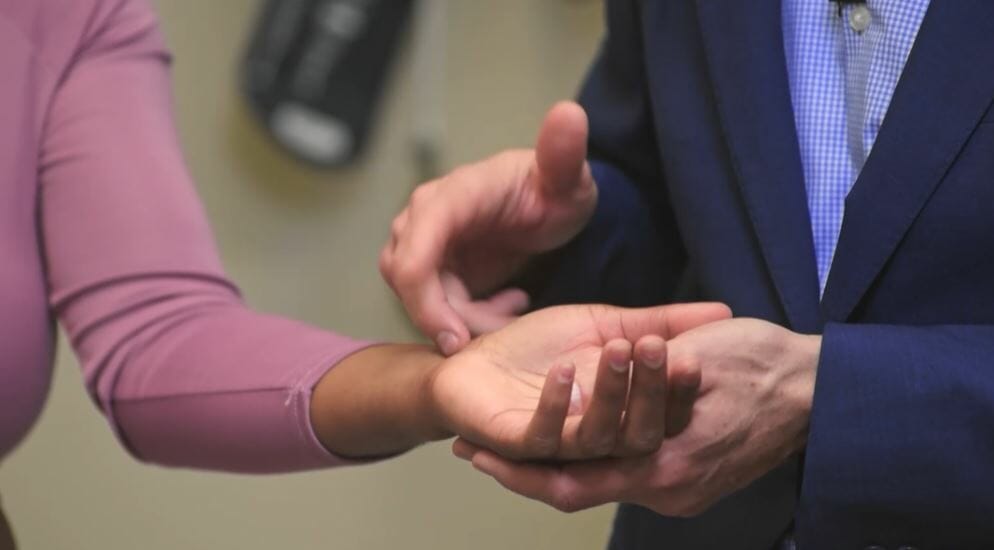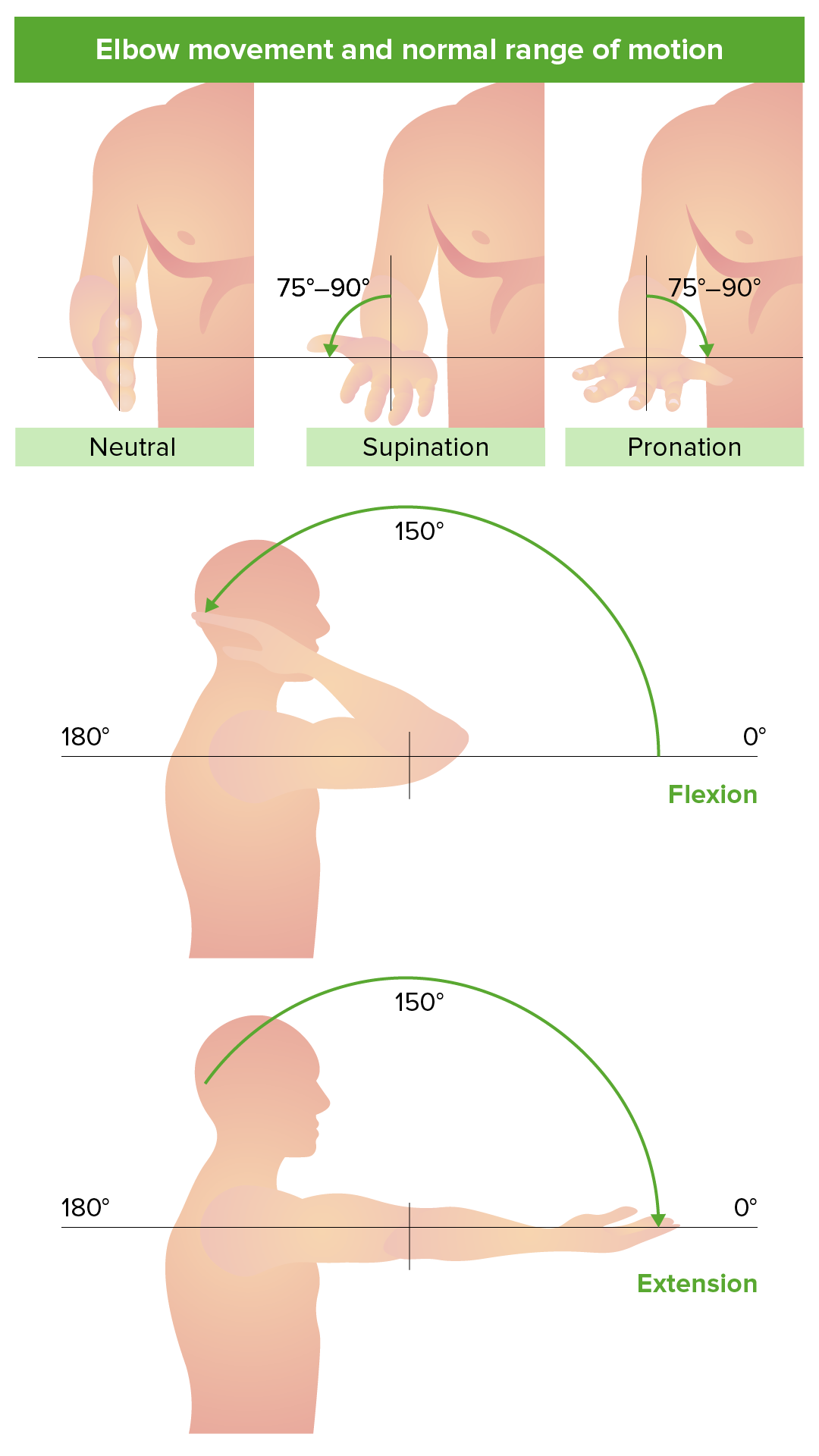Playlist
Show Playlist
Hide Playlist
Physical Exam Findings in Hand, Wrist, and Elbow
-
Reference List Physical Examination.pdf
-
Download Lecture Overview
00:01 With that, let's start talking about some specific diagnoses that patients oftentimes present with that we're trying to assess. 00:07 So the first of which is carpal tunnel syndrome. 00:09 Patients with carpal tunnel syndrome have entrapments of the median nerve as it courses through the carpal tunnel. 00:16 And there's a number of classic findings that we associate with carpal tunnel syndrome, the first of which is just called Tinel's sign, which I always remember starts with T, which makes me think of tapping. 00:27 Simply tap on the carpal tunnel itself, overlying the median nerve in an effort to try and reproduce that median nerve neuropathy and the paresthesias that typically have it in the thumb, the index finger and then the radial side of the middle finger. 00:44 The next test is Phalen's test. 00:45 I'm just going to have you put your hands together like this and apply pressure to that to your wrists. 00:52 This is essentially a compression of the tunnel. 00:55 You're trying to essentially induce ischemia to the median nerve to the vasa vasorum, the blood supply to the median nerve in an effort to recreate the symptoms that the patient has been having. 01:07 You can relax now. 01:08 Essentially, a patient with carpal tunnel syndrome has a chronic ischemic neuropathy where there's damage to the nerve because of impaired blood supply. 01:18 So you're just trying to do these maneuvers to recreate that sensation. 01:22 And the third one is going to be the hand elevation test, which is kind of a newer kid on the block, so to speak. 01:27 And can you put your hands and elevate them? You'll have a patient do this for upwards of a minute. 01:33 And oftentimes I'll be getting more history from them once I'm suspecting carpal tunnel syndrome while I have their hands up in the air. 01:40 And the reason that this test works is, again, because of this idea of ischemia, by putting your hand up in the air, you're making a little bit harder for gravity to deliver blood through this already damaged and compressed blood supply to the median nerve. 01:55 So you're trying to reproduce the symptoms in that way. 01:57 Simultaneously, thank you for bringing your arms down again. 02:00 Patients with, for example, a C6 radiculopathy, so nothing to do with the blood supply to the median nerve, but a radiculopathy, they tend to get better when they put their hands up in the air because you're actually taking tension off the C6 nerve root by putting your hands up in the air. 02:18 Next up, we'll take a look at De Quervain's tenosynovitis. 02:21 This is also a relatively common condition and it's going to be essentially inflammation in the extensor tendon sheaths here going to the thumb. 02:32 And the most common test that we do for that is just put your thumb in your hand like this and I'm going to tilt your wrist down. 02:39 It's actually uncomfortable, even at baseline for folks who don't have the De Quervain's tenosynovitis So you want to compare one side to the other. 02:47 I'll tell you that folks who really have the De Quervain's tenosynovitis, it's not just uncomfortable, they'll like jump off their seat because you're putting tension on that tendon sheath. 02:57 That test is called the Eichhoff's test. 03:00 Oftentimes, it's mistakenly called the Finklestein test, but it's actually Eickhoff test. 03:06 In addition, a simpler test even than that is just to have the patient lift up their thumb against resistance. 03:11 Lift against me, sorry. 03:13 Just by basically activating her extensor tendons of her thumb, that may reproduce the pain of De Quervain's tenosynovitis. 03:23 And then lastly, we want to look for another common complaint, which is also in the same area. 03:28 So it's important to which test, and how to interpret these tests is basal joint arthritis, also known as first CMC arthritis or carpometacarpal joint arthritis I mentioned before how the CMC of the thumb is one of the few joints that actually is mobile compared with the CMCs in the rest of the hand. 03:50 And this joint can classically develops arthritis right in this spot. 03:54 And you could certainly have tenderness in that spot, though a person with De Quervain's tenosynovitis would also have tenderness there. 03:59 So the test we used to distinguish that is called the Grind test where you're taking that metacarpal bone, this is the metacarpal bone here and you're grinding it into the, you're grinding it proximally into the CMC joint. 04:13 Patients with osteoarthritis will not feel great when you do that. 04:17 And that will reproduce the discomfort from CMC arthritis. 04:20 Whereas since I'm not affecting the tendon sheath overlying that joint, it helps me to exclude De Quervain's tenosynovitis and to distinguish amongst those two conditions. 04:30 And lastly, we always say when you're doing the musculoskeletal exam to examine the joint above and below the place that the person is reporting pain. 04:37 Patients with pain radiating down the forearm may actually have a problem with their elbow in particular, medial or lateral epicondylitis, so-called tennis elbow and golfer's elbow. 04:51 And you'll have tenderness right over the epicondyles. 04:54 And that's where there's basically the insertion of these muscles and the tendons running past them is inflamed. 05:00 And what we simply do to test for those is all the extensors of the wrist are inserting on the lateral epicondyle. 05:08 So I just want you to make a fist and I want you to lift it up and I'm going to push down. 05:12 If doing this causes her pain around the lateral epicondyle, that supports the diagnosis of lateral epicondylitis. 05:19 In contrast, rotate your wrist, and round and I'll flip up. 05:23 All these muscles of flexion of the wrist insert onto the medial epicondyle. 05:29 So tenderness that's reproduced in that area during this maneuver would support medial epicondylitis.
About the Lecture
The lecture Physical Exam Findings in Hand, Wrist, and Elbow by Stephen Holt, MD, MS is from the course Examination of the Upper Extremities.
Included Quiz Questions
Which nerve is affected with carpal tunnel syndrome?
- Median nerve
- Radial nerve
- Ulnar nerve
- C6 nerve root
- C7 nerve root
What condition is tested for by Eichhoff's test?
- De Quervain's tenosynovitis
- Carpal tunnel syndrome
- Ganglion cyst
- C6 radiculopathy
- Osteoarthritis of the base of the thumb
What condition do Phalen's and Tinel's signs test for?
- Carpal tunnel syndrome
- De Quervain's tenosynovitis
- Osteoarthritis of the base of the thumb
- Ganglion cyst
- C6 radiculopathy
Customer reviews
5,0 of 5 stars
| 5 Stars |
|
5 |
| 4 Stars |
|
0 |
| 3 Stars |
|
0 |
| 2 Stars |
|
0 |
| 1 Star |
|
0 |






